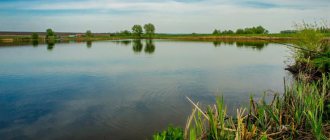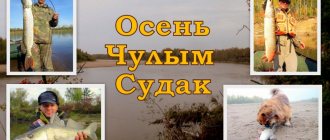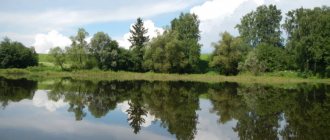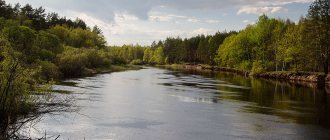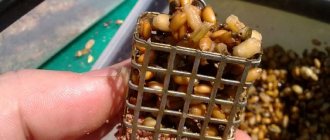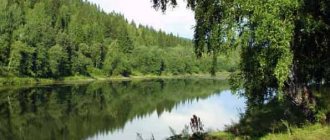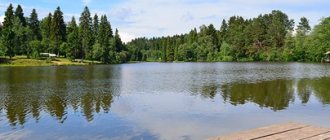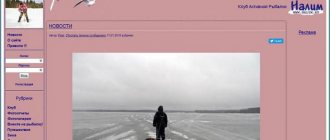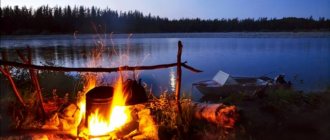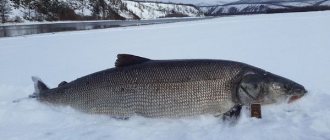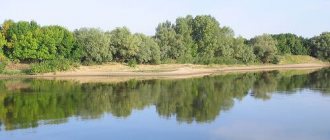Description of the reservoir
The Seim River is medium in size. It flows through the territory of the Belgorod and Kursk regions, as well as through the Sumy and Chernigov regions of Ukraine. The characteristics of the reservoir are as follows:
- river length – 696 km;
- pool area – 27500 sq. km;
- water consumption - 99.6 cubic meters. meters per second;
- the river slope is directed to the southwest;
- the width of the channel ranges from 10 to 100 meters;
- average depths are about 2–3 meters, maximum depths are up to 15 meters.
The Seim River originates in the Central Russian Upland. There are two versions regarding the exact location of the source of the reservoir:
- in the area of the village of Verkhoseimye, Manturovo district, Kursk region;
- near the Morozov farm in the Belgorod region of the Gubkinsky urban district.
Almost 65% of the Seim River basin area is in the Kursk region. Its valley is wide, the main rocks are chalk and limestone. The banks are hilly, in some places reaching a height of up to 40 meters. There are many ravines and ravines along the riverbed, and there are open and wooded areas.
In the upper reaches, the width of the Seim ranges from 10 to 20 meters
In the upper reaches the width of the Seim does not exceed 20 meters. In the middle reaches - from 40 to 80 meters. In the lower reaches the river overflows to 80–100 meters. The depths are also varied. On riffles - from 20 cm to a meter, on reaches and calm areas - 2-4 meters, there are holes and pools from 10 to 15 meters.
The river bed is winding, smoothly but noticeably “winding”, forming bends and pronounced turns. The current is mostly moderate, there are areas with rapids, and there are quiet reaches. The diet freezes at the end of November - beginning of December, opens at the end of March, less often at the beginning of April. The flood lasts until the end of May.
For reference! The Seim River is fed by snow.
In the Kurchatovsky district of the Kursk region, the Seim flows along an artificial channel created during the construction of the Kursk Nuclear Power Plant. There are many settlements on the banks of the reservoir, including Kursk, Solntsevo, Pryamitsyno, the Karl Liebknecht Village, Lgov, as well as Kudintsevo, Rylsk, Glushkovo, Zvannoye, Tetkino.
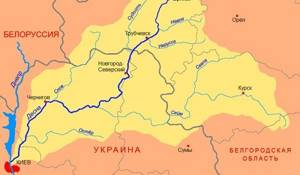
The Seim River flows through Russia and Ukraine and is a left tributary of the Desna
Within the Kursk region, the Seim River has 639 tributaries. From the left we can note:
- Seimitsa;
- Donetsk Seimitsa;
- Full;
- Reut;
- Strong;
- Snagost.
Among the right tributaries, the most significant are Leshchinka, Rat, Tuskar, Bolshaya Kuritsa, Svapa, Amonka. There are about 1000 lakes in the Seim basin. The main ones are Lezvino, Malino, Makovye, Fitizh.
For reference! The map shows that the main tributaries of the Seim in the Kursk region are the Svapa and Tuskar rivers.
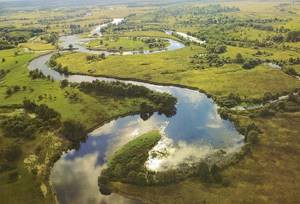
The Seim riverbed forms many bends and smooth turns
The banks of the Seim are densely populated. Therefore, the reservoir is actively used for economic purposes, for example, for irrigation of agricultural land. The river is not navigable along its entire channel, as there are embankments and shoals along its length. It is necessary to check the routes annually and clean them, which is done irregularly.
Rafting fishing on the Seim River PHOTO report
The previous eventful first and second days had left us pretty exhausted and we needed a sound and long sleep in order to fully face the third day.
And although fishing is often above all else for Kolya and me, our bodies had a slightly different opinion and required rest.
Therefore, despite the hole near the camp that was promising for fishing, we did not concentrate on it.
Although the places are clearly promising and fishy. We will come back here again!
We dropped the spinning rods for a bit, drank some hot tea and set off on our further journey.
The morning once again greeted us with freshness and coolness.
The guys are on the oars, and we continue to purposefully seek happiness in the form of biting worthy trophies.
Another twisted turn that is already familiar to us.
Occasionally you come across sailors wearing the same Meps Long No. 2.
Manipulations that the uninitiated cannot understand. Apparently something to do with bandaging.
But this is just a gorgeous place. Sejm. A sharp turn marks a long river stretch with a pine forest on the bank. The forest smells of pine trees and the singing of numerous birds can be heard. Bliss spreads throughout the body...
And again snags, washed-out banks and trees hanging over the water.
In this very place...
Kolya is getting a normal bite and 600 grams of pike are already on the kukan.
Let's take it, the fish stocks are over, and we still have two days to go.
And then the chicks came up to look at us handsome men and drink some water. Some fearless people have only their head sticking out of the water. Although there is a hole at the turn under the cliff...
Even toads peck at Long 2)
The river slows down, the turns become longer and more dreary. You have to turn on additional traction force.
The turn has been passed, another long stretch. This is the whole Seimas in its lower reaches. Very winding and with an abundance of trees and bushes in the water. Sharp turns give way to long straight sections.
The brush-noser also decided to taste the spinner. By the way, we are releasing the ruff-nosar in the Red Book of Ukraine. But the ruff is not. Although it is the ruff that is very difficult to meet in the Seimas.
We are approaching the place where, judging by the map, Seimas makes a turn of 100-100 degrees. An unrealistic place not only for this river, but also for any other lowland one.
We even sinfully thought that these were flaws in the map, of which there are many.
There are a lot of milkfish on the shore, and that’s understandable - the place is clearly fishy and has a depth and landscape that is rare for these places.
The place is unique - the deep pool is estimated to be 10 meters deep. A large bay is washed out on the left bank. A powerful current hits the shore and takes the river 100 degrees to the right. The breaker bank is made of thick rock, otherwise the river would have had a completely different direction.
The pool itself did not bring us any fish. There was no time to jig properly, and it was necessary to put a little more effort on the oars. It seemed to us that we were starting to get behind schedule.
This is the number one point for future fishing trips. You need to go here for 3-4 days in order to catch catfish, pike, perch and pike perch in a deep hole or at the exits from it.
Moreover, there are also points equipped for the needs of vacationers.
The next barge hauler gets to work.
A long straight section begins.
I continue to resist and wait for her dear one.
The thought cannot escape that all the worthy predatory fish were left behind there, in the pool.
Here's a good spot, a submerged tree in a depression under the bank that creates shade and slows down the water. Fish loves such places. Takes a break from the sun and stormy stream.
I lead the Long 2 spinner from the very edge of the water to the snag and here it is, for what all this is for - hundreds of casts, lack of sleep, shoveling hundreds of baits and animation methods - a powerful bite, I almost let go of the spinning rod out of surprise.
1-2 minutes of struggle and with powerful tackle I bring the fish to the raft. This is a pike.
It should be noted that taking fish on a raft is very inconvenient. We didn’t take a landing net as a matter of principle; bringing the fish close to the side is much more difficult than on a boat, and even once on the raft, it begins to struggle and often simply jumps into the water.
Here she is a beauty. There were no scales, but it was estimated to be well over 2 kg.
Not all the fish remained in the hole)))
After such a catch, excitement and a desire to continue spinning appear.
This is the kind of kukan we figured out for the two of us with Nikolai by the middle of the third day of the swim. There will be something to cook fish soup out of and fry it on the coals.
Here is a beautiful stream. From the point where it flows into the river, I manage to snatch three perches one after another. We release everyone - there are already enough fish.
We continue our path along the shoals that have replaced cliffs. The bite subsides.
Very wide and shallow area. You can go. Needless to say, the Seim is a river of contrasts!
Cool beer refreshes and gives energy and...the desire to sleep.
Writhing, writhing, writhing...
Lots of hooks. Something comes off, and something is saved thanks to powerful tackle and experience.
Here is a great place that brings us another good pike under a kilogram. We don’t even take a photo of the model, but, without torturing her right away, let her go.
The map shows us that the mouth is already nearby. There is still time before sunset, and we decide to lean on the oars and spend the night on the banks of the Desna.
Another turn of the Sejm. River is preparing to meet her older and more powerful sister.
There are many promising spots for fishing, but the fish are silent. Yes, and we are already tired. Holding a spinning rod almost out of your hands for three days gets tiring.
Plus on the kukan there are 4 pikes and a dozen perches motivating us to calm down.
The power of the river is felt in everything.
Toothed and striped, which will become our dinner at the rest. Sorry, fish, but that's nature's food chain.
This barge hauler has not yet pulled our cruiser. It's about time, we are in a hurry, and as luck would have it, the river takes us with a reverse current in the wrong direction.
Here is the last turn and the river is roaring, the raft will carry us into the pool or into...
The sun is getting lower, but we have to make it.
We are wasting time by sitting on a snag. But we jump off and swim further.
And here is Desna. The Seim, flowing into it, forms a powerful vortex and pit. The flows of two rivers formed a whirlpool, which also probably hides worthy trophies in its depths.
To be honest, my strength is already running out at this moment. Three days of active recreation are very pleasant, but a little tiring. And we face the last serious test for today - to cross the Desna River on a heavy and clumsy raft.
The Desna also turns in this place in such a way that the raft is carried by the current under the bank opposite to the one we need.
We invest heavily in our strokes. The sun is setting, warming us with its last rays.
And here it is, gum sand under your feet! We've been waiting for this for three days! Everyone is happy, everyone is happy to be together.
Photo for memory. That part of the catch that it was decided to take.
We choose a place to spend the night not for logical reasons, but simply the one that is closest. Right in the middle of the beach. Fatigue knocks you off your feet. I want to eat and relax.
We clean the fish, set up tents and collect firewood for the fire. We cook noodles and stew that have been in the bag for three days. There was no time for them when there was always fish soup and baked fish on the table.
We have dinner, tell stories and discuss tomorrow’s final push, illuminated by the bright moonlight.
It’s 6 am, I should still sleep, but the hearts of the spinners are calling to the river bank.
The fog covers the Desna with a silk blanket.
I move upstream in search of deeper promising places. From time to time I soak this or that bait in the water.
Under the cliffs it is relatively not deep, a little deeper than in the Seimas.
Twin rivers. It's just that one is noticeably larger than the other. And so the same snags and the same loops among forests and fields.
The depths begin further, but you can’t get there. The best way to fish such wide rivers is trolling. What we were able to verify. There are a great many trollers on the Desna.
The fish is silent, I don’t resist. Thousands of casts in just over 3 days make their presence felt.
I return to the still sleeping camp. Guys who are not fishermen naturally sleep, and I understand them.
The sun rises, so do the tourists.
Standard morning fire. Let's brew some tea and bake some fish.
It's time to go. The last day of our journey passes along the Desna. Swim just a short distance to the village of Maloye Ustye. And then we still need to get back home in time.
These places are popular among vacationers. Very beautiful and unusual, they are rich in fish in two rivers, mushrooms and berries in the adjacent forests. It’s also quite easy to get here and there are villages nearby where you can buy more provisions.
Kolya snatches the Desnyansky perch onto the Mansovsky Predator in yellow. The striped whale goes further to swim.
But at the turn of Malos Ustye. Let's go there.
The bank is reinforced with gravel fenders so that the river does not wash away the huts sooner or later.
Berth. The end point has been reached! Tired, but satisfied with ourselves, we sort out our belongings.
A photo of the whole four as a souvenir of an unforgettable adventure.
A convenient staircase will help us.
The guys went for a cold beer. It will come in handy now. I am looking after a few belongings.
Here he is, our faithful servant and assistant all these three days and three nights. Thank you!
There is no reason for us to take him with us; we leave him at the mercy of the local residents.
And then, as if to mark the end of our journey, a light rain began to fall.
Our mood at this moment would not have been spoiled even by the rain.
And here he is, I had to hide a little.
What is typical is that during the entire period of our hike we did not get caught in the rain even once, although there were clouds almost the entire time. And as soon as they arrived, he launched them.
Soon a friend will come for us in a car and take us home, where we will share our impressions and memories for many more weeks.
The river is waiting for us, we will definitely come back!
What kind of fish live
The Seim is a fish river inhabited by a variety of ichthyofauna. Its main inhabitants are:
- chub;
- roach;
- perch;
- pike.
In smaller quantities here are found white bream, white bream, ide, rudd, tench, crucian carp, asp, and bluegill. In the lower reaches there are pike perch, catfish, and burbot. Among the small things you can find here are bleak, perch, gudgeon, dace, bitterling, loach and goby. There are not many trophy fish in the Seimas. But in a sufficient number of medium and weighty specimens.
Tourist routes and attractions
In the vicinity of the Seimas there are many ancient monasteries, churches, nature reserves and simply beautiful places.
Thus, the main attraction of Putivl is the Molchansky Monastery, located at the very top of Priseimsky Hill.
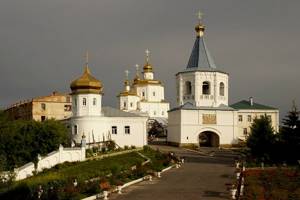
Molchansky Monastery.
It got its name from Lake Molche, located in the floodplain of the river. The main building of the monastery is the Cathedral of the Nativity of the Virgin Mary with a bell tower.
In the 12th century. in this place there was a wooden fort, and then a stone fortress was built. Hoping for the protection of strong walls, the monks built a courtyard inside it.
In 1597 the fortress became the property of the church. This meant that in case of war, the monks had to independently defend themselves from the enemy.
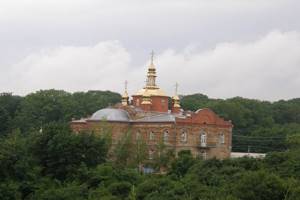
Sofronievsky Monastery.
A few kilometers from the Molchansky Monastery, on a hill that rises above the floodplain of the river, the Sofronievsky Monastery was built in 1405.
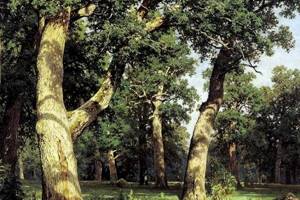
A forest park has been created near the village of Makarovka in the Kursk region, where there are oak trees that are more than 200 years old.
In the lower reaches along the banks of the Seim lies the Spadshchansky forest. This reserve is of significant interest to connoisseurs of natural beauty and history buffs.
During the Great Patriotic War, the partisan detachment of the legendary S.A. Kovpak operated here.
Holidays at the Seimas are wonderful at any time of the year. Fans of distant travels have long ago laid out tourist routes and created maps, thanks to which each tourist chooses in advance where to go.
Fishing
Many fishermen call the Seim the chub river. Indeed, there are a lot of this underwater inhabitant here. Moreover, there are weighty individuals whose mass exceeds 1.5 kg. This fish is hunted with light spinning rods and fly fishing. The best time to catch it is from May to the end of September.
A popular direction for catching bigheaded fish is considered to be rafting fishing with an ultralight spinning rod. The most catchy baits are miniature cranks. Micro-oscillators, small rotating spoons, and minnows up to 4 cm long also work.
Walking fishing on the Seim River with a spinning rod allows you, in addition to chub, to effectively catch other predatory representatives of the ichthyofauna. Among them are small-medium perch, pike up to 1.5 kg, and small asp. Less often, ide flies in; commercial rudd can take over.
Advice! To catch chub and ide in the summer, local fishermen use a tackle consisting of two combined spinning rods, called a constriction.
Good results when fishing for predators can be achieved using natural bait. The most effective are live bait or a rig with a dead fish. The fisherman also uses black leech, crayfish meat, large worm, and frog.
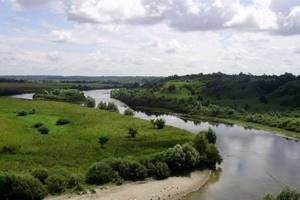
You should look for chub on riffles, bends in the riverbed, and near steep banks
Peaceful fish are caught mainly with float gear. When fishing near the shore, it is enough to take a regular fly rod with a blind rig. Dung worms, caddisfly larvae, maggots, and less often bloodworms, grasshoppers, and small beetles are used as baits.
Among the attachments are:
- dough;
- canned corn;
- filamentous algae;
- crust of bread;
- parboiled wheat.
At long distances they fish with match and Bolognese fishing rods, or you can use an inflatable boat.
Bottom gear is fished mainly at medium and great depths. You can use both modern feeder gear and old-fashioned hooks, weights and elastic bands. From baits and attachments similar to the float directions of the bait.
In winter, people catch fish on the Seimas using vertical spoons and balance beams. You can use jigs near the shore. In quiet areas and in the sleeves, they place girders and stands. From the ice on the river they mainly hunt for perch, roach, silver bream, ruffe and pike.
Fishing and rafting
Seim is popular among fishing enthusiasts. After the end of spawning on the river, dozens and hundreds of people appear who want to sit on the bank with a fishing rod. Families come here; in the summer, tents and campfires appear near the Seim. The best time for fishing is June or July.
Perch, pike, and bream are caught using spinning rods and regular fishing rods. There are a lot of fish, chub and perch are hiding in the coastal reeds, and pike are lying in wait for their prey in the grass on the left bank. In the spring you can catch asp in the Seimas. This fish swims along with strong currents and melt waters from the Desna. After the water subsides, the asp returns to its native habitat.
Winter types of fishing are also in demand. They seriously prepare for ice fishing, stocking up on clothing and gear. In winter, the river freezes almost completely, but neither snow drifts nor blizzards stop experienced fishermen.
Kayaking is also popular. The tourist season begins in April and ends in November. All this time, continuous lines of kayaks stretch along the Seim. During the trip, many fish, sunbathe on the beach and visit attractions, the abundance of which is famous for the coastal cities and villages.
Spearfishing
The Seim is considered not only a fishing reservoir. Underwater hunters love to visit this river. It is suitable for beginner divers who have little experience. The conditions here are favorable for beginners - clean water, calm currents, and plenty of fish.
On the Seimas you can hunt ide, chub, pike, and catfish. There are references to the capture of carp, heavy crucian carp and tench. The most promising areas are the middle reaches. It is better to go to the reservoir in the warm season, from June to the end of August.
Holidays at the Seimas
The Seim is a picturesque and comfortable river for relaxation, which many residents of the Kursk region like to visit. Some lovers go to stationary sites on the shore of a reservoir, while others prefer rafting tourism on kayaks, inflatable rafts or boats.
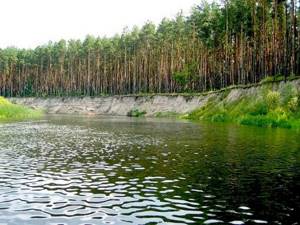
There are many picturesque places to relax on the Seim River
The best time for water tourism on the Seimas is summer, from July to August. During this period of the year, the banks of the reservoir are very crowded, so for those who love peace and solitude, it is advisable to choose another river or go to these places in spring or autumn.
